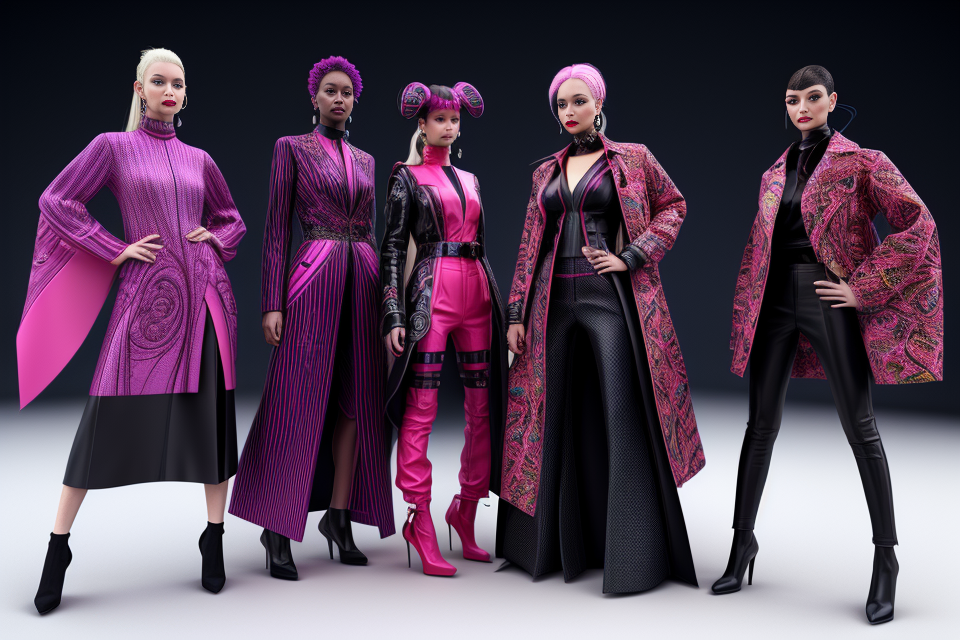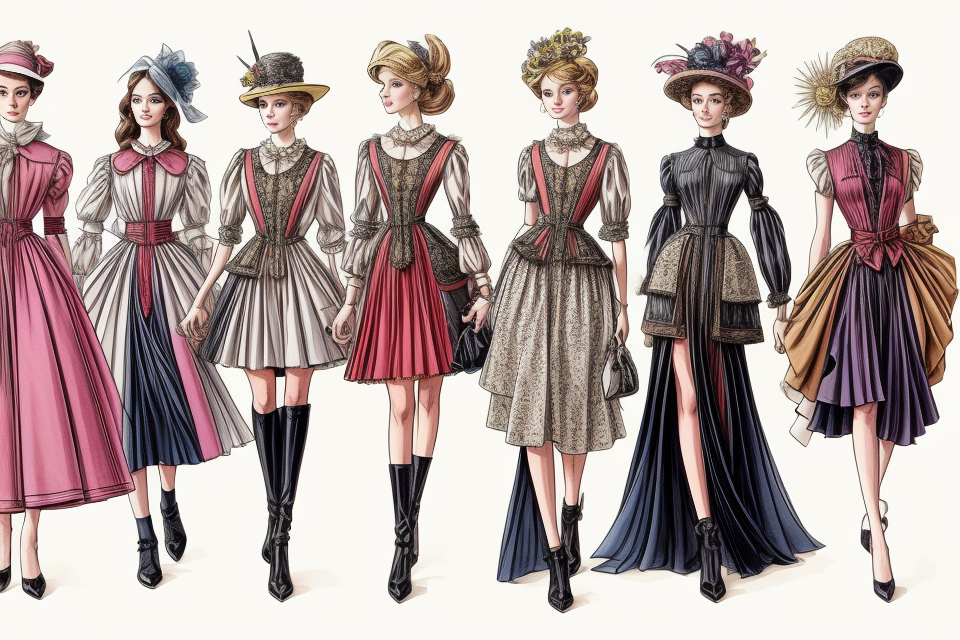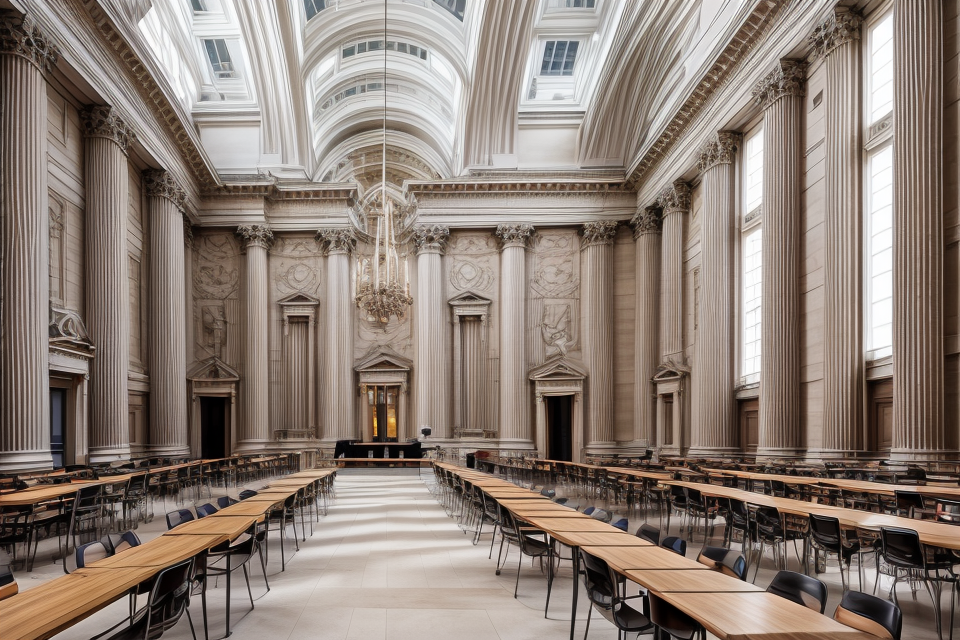
The fashion industry has always been known for its creativity and innovation, with fashion designers leading the way in shaping the latest trends and styles. However, with the rapid advancement of artificial intelligence (AI), there is a growing concern that these creative minds may be replaced by machines. In this article, we will explore the future of the fashion industry and examine whether AI will replace fashion designers. We will delve into the current state of AI in fashion, the pros and cons of AI-designed fashion, and the impact it may have on the industry as a whole. So, buckle up and get ready to explore the fascinating world of AI and fashion!
The Rise of AI in Fashion Design
The Benefits of AI in Fashion Design
- Increased Efficiency
- AI technology can streamline various aspects of the design process, such as pattern making and sample production, resulting in faster turnaround times and reduced costs.
- With AI, designers can quickly generate multiple design options, allowing them to quickly narrow down their choices and focus on the most promising ideas.
- Improved Accuracy
- AI algorithms can analyze large amounts of data and make predictions with greater accuracy than humans.
- This means that AI can help designers identify trends and consumer preferences more accurately, leading to more successful product launches.
- Enhanced Creativity
- AI can help designers explore new design possibilities and push the boundaries of traditional fashion design.
- For example, AI can generate unique textile patterns and colors, or suggest unconventional design elements that might not have been considered otherwise.
- By automating repetitive tasks, AI also frees up designers’ time and mental energy, allowing them to focus on more creative aspects of the design process.
The Limitations of AI in Fashion Design
Although AI has made significant advancements in the fashion industry, it still has limitations that make it difficult to replace human fashion designers entirely. Some of these limitations include:
- Lack of Human Touch: AI-generated designs lack the human touch that can bring a unique perspective and personal experience to the design process. While AI can analyze data and generate patterns, it cannot replicate the creativity and intuition that a human designer brings to the table.
- Limited Understanding of Human Emotions: Fashion is not just about functionality, but also about expressing emotions and making a statement. Human designers understand the psychology of fashion and can create designs that evoke emotions and tell a story. AI, on the other hand, can only analyze data and generate designs based on what has been programmed into it.
- Inability to Replicate the Designer’s Vision: Each fashion designer has a unique vision and style that sets them apart from others. AI may be able to generate designs based on data and trends, but it cannot replicate the designer’s vision or personal style. Human designers bring their own experiences and perspectives to the table, which cannot be replicated by AI.
The Impact of AI on Fashion Designers
Changes in the Design Process
As AI continues to advance, it is poised to revolutionize the fashion industry, transforming the role of fashion designers in the process. The following are some of the changes that we can expect to see in the design process:
- Reduced Role in Design
One of the most significant changes that AI is likely to bring about is a reduction in the role of fashion designers in the design process. With AI capable of generating designs, predicting trends, and suggesting materials, designers may find themselves taking a back seat in the creative process. Instead of being the primary drivers of design, they may instead serve as curators, guiding the AI’s creative output and making final decisions on which designs to pursue. - More Collaboration with AI
As AI becomes more integrated into the design process, fashion designers will need to develop new skills to work alongside these technologies. This may involve learning how to input data into AI systems, interpreting the results generated by AI algorithms, and working with AI to refine and iterate on designs. In this new collaborative model, designers will need to be able to communicate effectively with AI systems, translating their creative vision into language that the machines can understand. - New Skills Required
As the role of fashion designers changes, so too will the skills required to succeed in the industry. Designers will need to become proficient in working with AI technologies, developing the ability to input data, interpret results, and collaborate with AI systems to create innovative designs. They will also need to develop new skills in areas such as data analysis, machine learning, and algorithmic design, as these will become increasingly important in the fashion industry. Additionally, designers will need to be able to work with a range of technologies, including 3D printing, virtual reality, and other cutting-edge tools that are transforming the industry.
Job Displacement
Potential for Automation
As AI continues to advance, it is becoming increasingly capable of performing tasks that were once the exclusive domain of human experts. One area where this is particularly evident is in the fashion industry, where AI is being used to automate tasks such as pattern-making, grading, and even design. This has the potential to significantly reduce the need for human labor in the fashion design process, leading to job displacement for fashion designers.
AI’s Ability to Learn and Improve
Another factor that contributes to the potential for job displacement in the fashion industry is the ability of AI to learn and improve over time. AI algorithms can be trained on vast amounts of data, allowing them to identify patterns and make predictions with increasing accuracy. This means that as AI systems become more sophisticated, they may be able to produce designs that are just as innovative and creative as those produced by human designers, but at a fraction of the cost.
The Future of Fashion Designer Jobs
While it is true that AI has the potential to significantly disrupt the fashion industry, it is important to note that this does not necessarily mean that all fashion designers will lose their jobs. In fact, many experts believe that the role of the fashion designer will simply evolve over time. Rather than focusing solely on the design process, fashion designers may be called upon to oversee the work of AI systems, serving as creative directors and ensuring that the final product meets the desired aesthetic standards. Additionally, there will likely always be a demand for human creativity and innovation in the fashion industry, and designers who are able to bring a unique perspective and vision to their work will continue to be highly valued.
The Role of Fashion Designers in an AI-Driven Industry
Adapting to the New Reality
Embracing AI Technology
As AI continues to reshape the fashion industry, fashion designers must embrace this technology and learn how to integrate it into their workflow. This may involve learning new software and tools, as well as understanding the limitations and potential of AI in fashion design.
Developing New Skills
Fashion designers must also develop new skills to remain relevant in an AI-driven industry. This may include learning about data analysis, machine learning, and other technical skills that are becoming increasingly important in the fashion industry.
Exploring New Design Opportunities
Finally, fashion designers must explore new design opportunities that are made possible by AI. This may involve using AI to generate new designs, analyze consumer data, and develop more sustainable and ethical fashion practices. By embracing AI and exploring new design opportunities, fashion designers can continue to push the boundaries of the industry and create innovative and unique designs.
The Future of Fashion Design
AI as a Tool, Not a Replacement
In the future, AI will likely play a significant role in the fashion industry as a tool for designers to enhance their creativity and streamline their workflow. However, it is important to note that AI will not replace human designers entirely. Instead, it will augment their abilities and enable them to focus on more high-level tasks.
The Importance of Human Creativity
Despite the advancements in AI, fashion design remains an inherently human activity that requires creativity, empathy, and an understanding of culture and society. AI can assist in generating designs and patterns, but it cannot replicate the intuition and emotional intelligence that human designers bring to the table.
The Evolution of the Fashion Designer’s Role
As AI continues to advance, the role of fashion designers will evolve. They will need to adapt to new technologies and learn how to work alongside AI to create innovative and sustainable designs. This will require a shift in mindset and a willingness to embrace change.
Overall, the future of fashion design lies in the integration of AI and human creativity. By working together, designers can push the boundaries of the industry and create new and exciting fashion concepts that reflect the needs and desires of a rapidly changing world.
FAQs
1. What is AI in fashion design?
AI in fashion design refers to the use of artificial intelligence and machine learning algorithms to assist in the design process. This can include tasks such as generating designs, predicting trends, and optimizing patterns.
2. How is AI being used in fashion design?
AI is being used in fashion design in a variety of ways. For example, it can be used to generate new designs based on existing patterns and styles, predict consumer trends, and optimize the pattern-making process.
3. Can AI completely replace human fashion designers?
While AI can certainly assist in the design process, it is unlikely to completely replace human fashion designers. Fashion design is a highly creative and subjective field, and human designers bring a unique perspective and vision to their work. Additionally, there are certain aspects of the design process, such as the emotional and cultural significance of fashion, that are difficult for AI to replicate.
4. What are the benefits of using AI in fashion design?
The benefits of using AI in fashion design include increased efficiency, reduced waste, and improved accuracy. AI can also assist in the prediction of consumer trends and the optimization of the design process.
5. What are the potential drawbacks of using AI in fashion design?
Potential drawbacks of using AI in fashion design include the risk of homogenization of designs and the potential loss of creativity and innovation. Additionally, there is the concern that AI may perpetuate biases and stereotypes present in the data it is trained on.
6. Will AI replace human fashion designers?
It is unlikely that AI will completely replace human fashion designers. While AI can certainly assist in the design process, it is important to recognize the unique perspective and creativity that human designers bring to their work. AI and human designers will likely work together in the future to create innovative and inspiring designs.


